The evidence for the resurrection includes early accounts from Christian and non-Christian sources, testimonies of Jesus appearing after his death, and the empty tomb that challenges skeptics. Archaeological findings such as artifacts support biblical stories, while prophecies from Isaiah and Psalms align with Jesus’ life events. Witness transformations and the growth of Christianity also demonstrate the profound impact of the resurrection. To discover more, explore how all these elements come together to strengthen this historical and spiritual claim.
Key Takeaways
- Multiple early Christian and non-Christian sources document miraculous healings and appearances of Jesus after His death.
- The empty tomb, confirmed by consistent accounts and burial artifacts, signifies a physical event supporting the resurrection.
- Post-resurrection appearances and miracles, including healings and prophetic fulfillments, provide tangible evidence of Jesus alive.
- The transformation of disciples from fear to boldness and rapid growth of early Christianity demonstrate the impact of the resurrection.
- Archaeological finds and fulfilled biblical prophecies, such as Isaiah 53 and Micah 5:2, reinforce the historical and divine credibility of the resurrection.
Historical Accounts and Early Testimonies
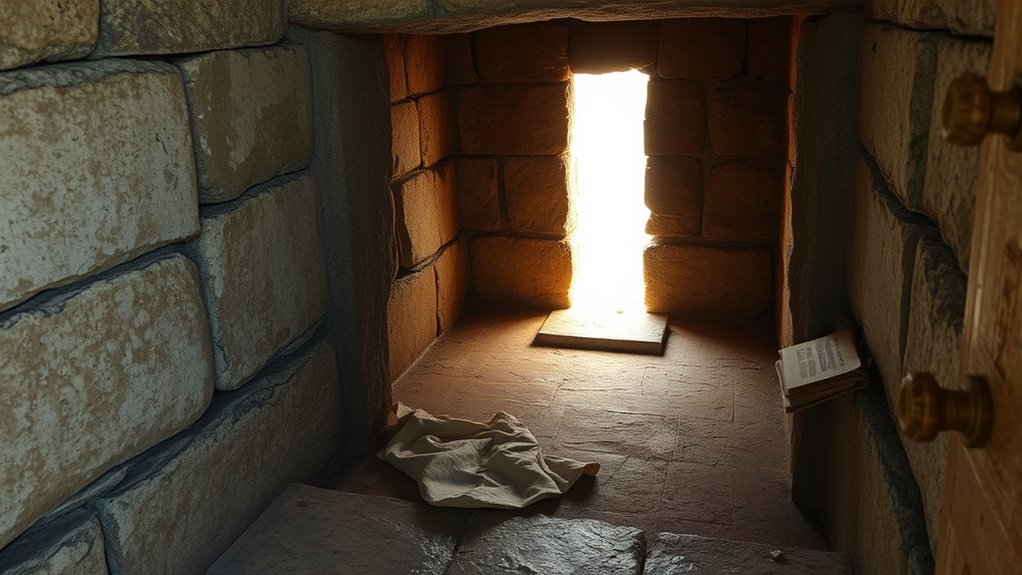
Historical accounts and early attestations provide some of the most direct evidence for the resurrection. These records document remarkable events, such as miraculous healings, that followers attributed to Jesus after His death. Witnesses reported these healings as signs of divine power, reinforcing the belief in His resurrection. Additionally, early texts highlight prophetic fulfillments, where Jesus’s life and death matched Old Testament predictions, strengthening the credibility of these accounts. These attestations come from diverse sources, including Christian and non-Christian writers, and date close to the events themselves. By examining these historical narratives, you see consistent patterns pointing to a transformative event that changed countless lives. They serve as foundational evidence, anchoring the resurrection in both spiritual significance and historical authenticity.
The Empty Tomb Narrative
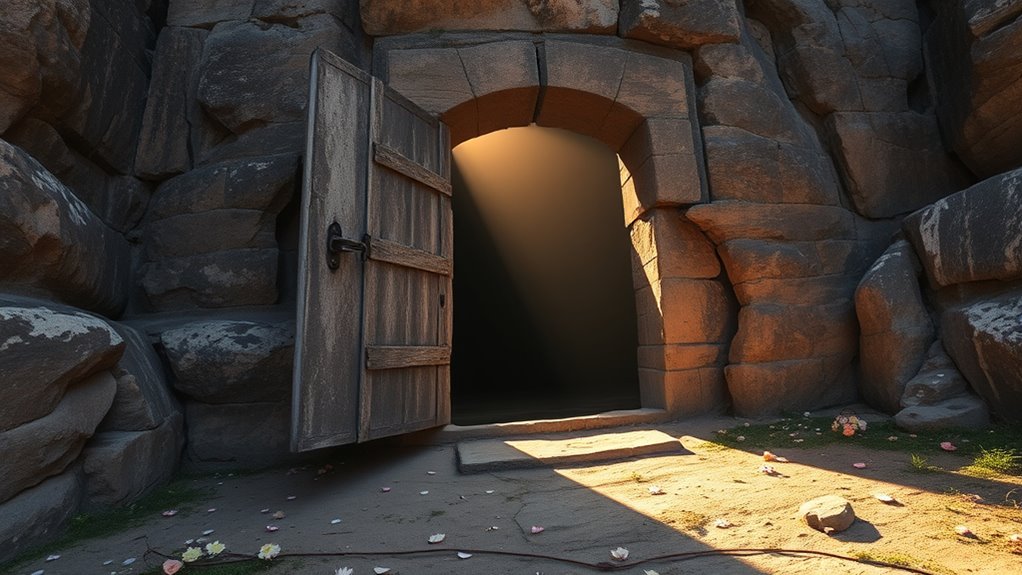
The empty tomb narrative stands as one of the most compelling pieces of evidence for the resurrection. It symbolizes more than just a physical space; it embodies symbolic symbolism that highlights new life and divine power. The fact that Jesus’ body was missing challenges skeptics and invites theological interpretation, suggesting that death was conquered. Early witnesses reported the tomb’s emptiness, which became a cornerstone for the resurrection claim. This narrative also emphasizes the significance of the tomb’s emptiness in Christian faith, representing hope and renewal. The consistent account across different sources strengthens its credibility. Ultimately, the empty tomb serves as a foundational element, pointing to a reality beyond mere history—an event with profound spiritual and theological implications.
Post-Resurrection Appearances of Jesus
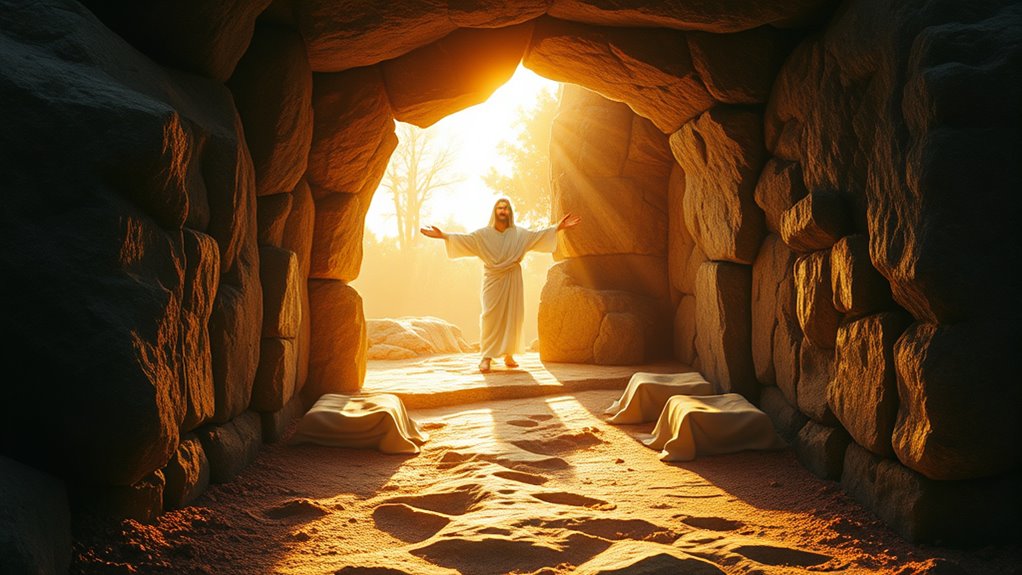
After the empty tomb, Jesus’s post-resurrection appearances serve as powerful evidence for his rise from the dead. During these encounters, he performs miraculous healings and fulfills prophetic scriptures, confirming his divine mission. These appearances are documented by witnesses who see him alive, providing tangible proof of his resurrection. You can see in the table below how these events reinforce the truth of his risen state:
| Appearance Location | Key Event |
|---|---|
| Emmaus | Jesus explains scriptures, fulfilling prophecy |
| Galilee | Miracle of the catch of fish |
| Jerusalem | Thomas doubts then believes |
These appearances aren’t just stories—they demonstrate Jesus’s authority and divine purpose through miraculous healings and prophetic fulfillments.
The Transformation of the Disciples

You can see how the disciples’ fear turned into bold courage after the resurrection, transforming their entire outlook. Their dramatic shift from doubt to unwavering commitment surprised many, proving something extraordinary happened. This renewed purpose fueled the apostles’ mission, leading them to spread their message with unmatched passion.
Changed Fear Into Courage
Although the disciples initially feared for their safety after Jesus’ crucifixion, a remarkable transformation occurred that turned their fear into unwavering courage. Instead of retreating, they engaged in meditative prayer, deepening their faith and gaining strength. This spiritual practice helped them process their doubts and fears, allowing them to stand firm. Their participation in theological debates also sharpened their understanding of Jesus’ teachings, fueling their conviction. The fear that once held them back was replaced by a boldness rooted in their experiences and beliefs. They began to openly proclaim the resurrection, even facing threats and persecution. This shift shows how their encounters with the risen Jesus inspired a profound change, transforming fear into courageous conviction that endures to this day.
Witnesses’ Dramatic Shift
The disciples’ transformation from fearful followers to bold witnesses marks one of the most dramatic changes in history. Their testimonies’ credibility skyrocketed as they confidently proclaimed the resurrection, even facing persecution and death. This shift demonstrates remarkable eyewitness reliability; despite previous doubts and fears, they publicly affirmed what they saw and experienced. Their changed lives add weight to their accounts, showing they genuinely believed in the resurrection’s truth. The consistency of their testimonies across different times and locations further strengthens their credibility. If their stories were fabricated, it’s unlikely they would have maintained such unwavering conviction under intense pressure. Their dramatic shift from skepticism to conviction provides compelling evidence that their eyewitness testimonies are trustworthy and rooted in real encounters.
Mission Reignited in Apostles
The transformation of the apostles after witnessing the risen Christ reignited their mission and boldness. This shift was driven by divine intervention, which sparked a profound spiritual awakening within them. Before, they were fearful and uncertain, but after seeing Jesus alive, their confidence and purpose surged. The resurrection served as undeniable evidence, fueling their conviction to spread the message. Their newfound courage was not just human resolve; it was empowered by divine force, inspiring them to face persecution and hardship. This spiritual awakening transformed ordinary men into fearless witnesses, committed to their divine calling. Their renewed passion and unwavering dedication prove that the resurrection genuinely changed lives, igniting a worldwide mission rooted in divine truth and spiritual renewal.
The Growth of the Early Christian Movement

Have you ever wondered how a small group of followers transformed into a widespread movement? It all began with their bold use of Christian symbolism and religious rituals that set them apart. These symbols, like the fish and the cross, communicated their beliefs secretly and reinforced unity. Religious rituals, such as baptisms and Eucharist celebrations, helped believers connect deeply and share their faith openly. As more people encountered these practices, they spread quickly throughout cities and regions. The movement’s message of hope and resurrection resonated, inspiring conversions and community building. Your understanding of these early practices shows how faith, combined with powerful symbols and rituals, fueled the rapid growth of Christianity from a tiny sect into a global religion.
Archaeological Discoveries Supporting Biblical Accounts
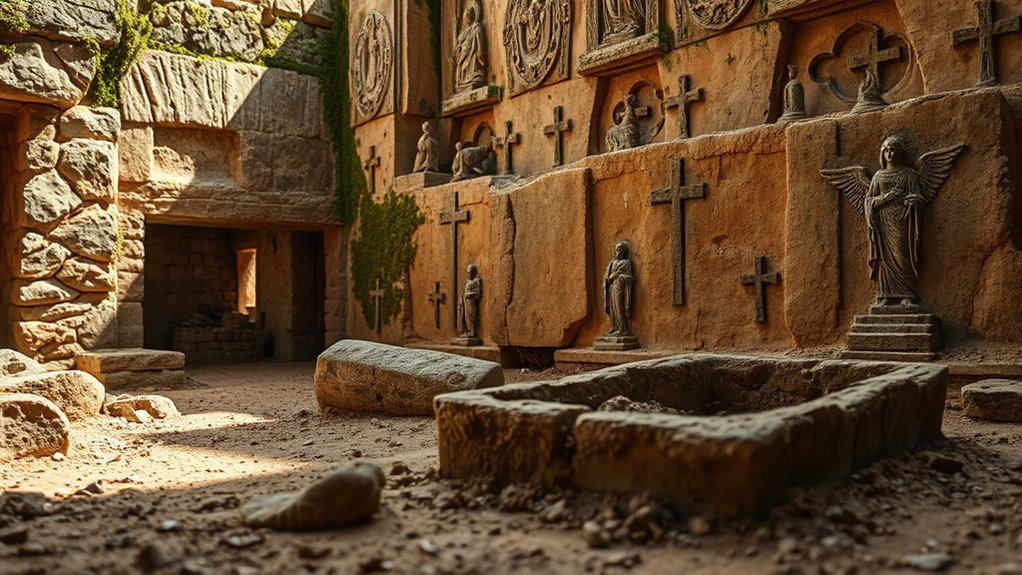
Archaeological discoveries have uncovered ancient tombs that align with biblical descriptions, lending credibility to the accounts. Artifacts found at these sites support the narratives, providing tangible connections to biblical events. These findings strengthen the historical foundation behind the resurrection story.
Ancient Tombs Confirmed
Recent discoveries of ancient tombs have provided compelling evidence that aligns with biblical accounts, offering tangible links to historical figures and events. These tomb discoveries often include burial artifacts that support biblical narratives. For example:
- The Tomb of the Potters, which contained artifacts matching biblical references to early Jerusalem.
- The tombs in the Valley of Elah, associated with soldiers from biblical stories.
- The discovery of ossuaries with inscriptions that suggest connections to biblical families.
These findings strengthen the historical credibility of biblical accounts, helping you see the tangible evidence behind the stories. The tomb discoveries and burial artifacts serve as physical proof, bridging archaeology and scripture, and affirming the historical basis of the biblical narrative.
Artifacts Supporting Narratives
Numerous artifacts unearthed through archaeology provide tangible support for biblical narratives, reinforcing their historical authenticity. These artifacts often feature symbolism that aligns with biblical stories, helping you understand their cultural context. For example, seals, inscriptions, and pottery fragments reveal details about ancient practices and beliefs. Through careful archaeological dating, experts confirm these artifacts originate from the periods described in biblical accounts, strengthening their credibility. When you study these objects, you see how they connect directly to biblical events, such as the resurrection or the life of Jesus. The symbolism embedded in artifacts offers visual confirmation of biblical themes, making the narratives more concrete. Overall, archaeological discoveries serve as essential pieces of evidence, bridging the gap between history and scripture.
The Role of Early Christian Writings and Letters

Early Christian writings and letters play a crucial role in understanding the evidence for the resurrection because they provide firsthand accounts and early testimonies of Jesus’ followers. These documents, written close to the time of the events, preserve core beliefs and experiences. For example, early Christian hymns express joy and conviction about Jesus’ resurrection, reinforcing its significance. Additionally, apostolic creeds serve as concise summaries of core doctrines, emphasizing the resurrection’s central role. To deepen your understanding, consider:
- Examining early hymns that celebrate Jesus’ victory over death.
- Analyzing apostolic creeds that affirm the resurrection as foundational.
- Recognizing how these writings reflect the early church’s unwavering belief in Jesus’ rise from the dead.
These writings offer compelling evidence of the resurrection’s historical importance.
Fulfillment of Prophecies and Biblical Predictions
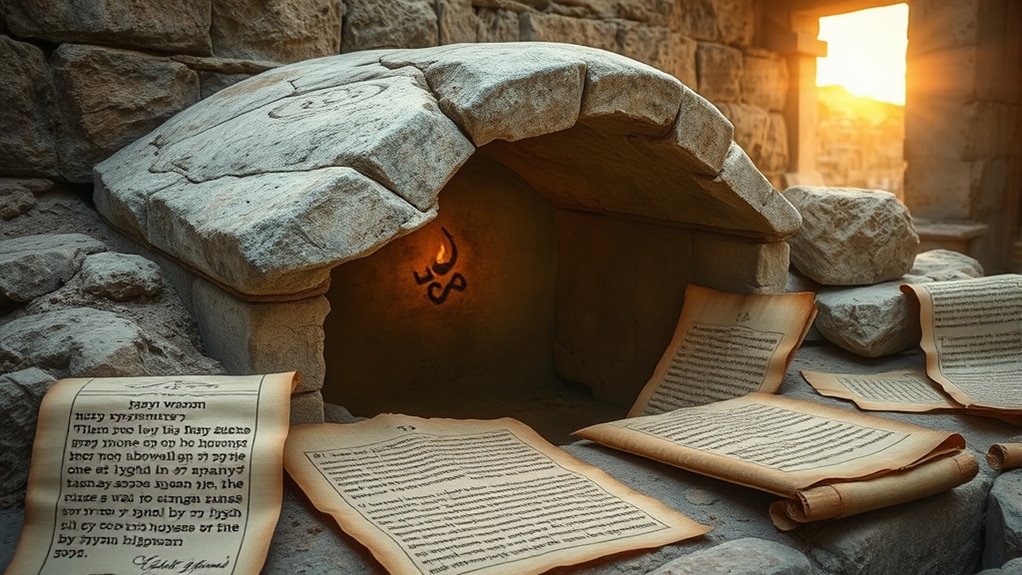
The writings and testimonies from early Christians not only highlight their belief in Jesus’ resurrection but also point to a deeper fulfillment of biblical prophecy. These biblical predictions, spanning centuries, align precisely with events in Jesus’ life, death, and resurrection. For example, Isaiah’s prophecy about the suffering servant and Psalm 16’s promise of resurrection were fulfilled in remarkable ways. This prophecy fulfillment strengthens the case that Jesus’ resurrection was part of a divine plan. To illustrate, consider the following:
| Prophecy | Biblical Prediction | Fulfillment |
|---|---|---|
| Isaiah 53 | Messiah suffering and dying | Jesus’ crucifixion |
| Psalm 16 | Resurrection and eternal life | Jesus rising from the dead |
| Daniel 9:26 | Messiah’s death and end of sacrifices | Jesus’ crucifixion and temple veil tearing |
| Micah 5:2 | Birth in Bethlehem | Jesus’ birthplace |
This pattern of prophecy fulfillment underscores the biblical predictions surrounding the resurrection.
Frequently Asked Questions
How Do Skeptics Interpret the Resurrection Accounts?
When you consider how skeptics interpret the resurrection accounts, they often analyze the historical context and cultural influences surrounding the stories. They see these accounts as influenced by religious beliefs and societal norms of the time, rather than actual events. Skeptics argue that stories may have been shaped by myth-making or theological motives, and they question the reliability of the sources, emphasizing a need for empirical evidence over faith-based narratives.
What Scientific Evidence Supports the Resurrection Claim?
You might wonder what scientific evidence supports the resurrection claim. While miraculous phenomena like resurrection defy natural laws, some point to historical documentation of Jesus’ death and reports of his appearances afterward. Although science can’t directly verify supernatural events, these accounts provide context. Ultimately, the resurrection remains a matter of faith and historical interpretation, not empirical scientific proof.
Are There Any Non-Christian Sources Confirming the Resurrection?
You might wonder if non-Christian sources confirm the resurrection. While most ancient manuscripts and historical testimonies from outside Christianity don’t explicitly mention the resurrection, some references, like Jewish historian Josephus and Roman writers Tacitus and Suetonius, acknowledge Jesus’ existence and crucifixion. However, they don’t directly confirm the resurrection. These sources support the historical context but don’t provide direct evidence of the miraculous event itself.
How Do Cultural Differences Impact Resurrection Beliefs?
You see how cultural differences shape beliefs, influence perceptions, and color interpretations. Cultural interpretations of resurrection vary widely, shaping how people understand divine power, life after death, and spiritual renewal. These influences create diverse perspectives, where some see resurrection as literal truth, others as metaphorical meaning, and still others as symbolic stories. Your belief is molded by these cultural lenses, highlighting how cultural interpretations deeply impact individual and collective resurrection beliefs.
What Psychological Explanations Exist for Post-Resurrection Experiences?
When exploring post-resurrection experiences, you find psychological phenomena like hallucinations or dreams can play a role. Cognitive biases, such as expectancy or confirmation bias, influence how you interpret these experiences, making you more likely to see them as supernatural. These psychological explanations suggest that your mind actively constructs these experiences, especially during times of grief or stress, rather than them being literal events.
Conclusion
Considering all the historical accounts, empty tomb stories, and early testimonies, it’s compelling to question whether the resurrection truly happened. Could these combined pieces of evidence be coincidence, or do they point to a divine miracle? You’re left to decide if faith or history offers the stronger proof. What if the resurrection isn’t just a story, but a reality that changed history forever? The evidence invites you to explore this profound possibility.










